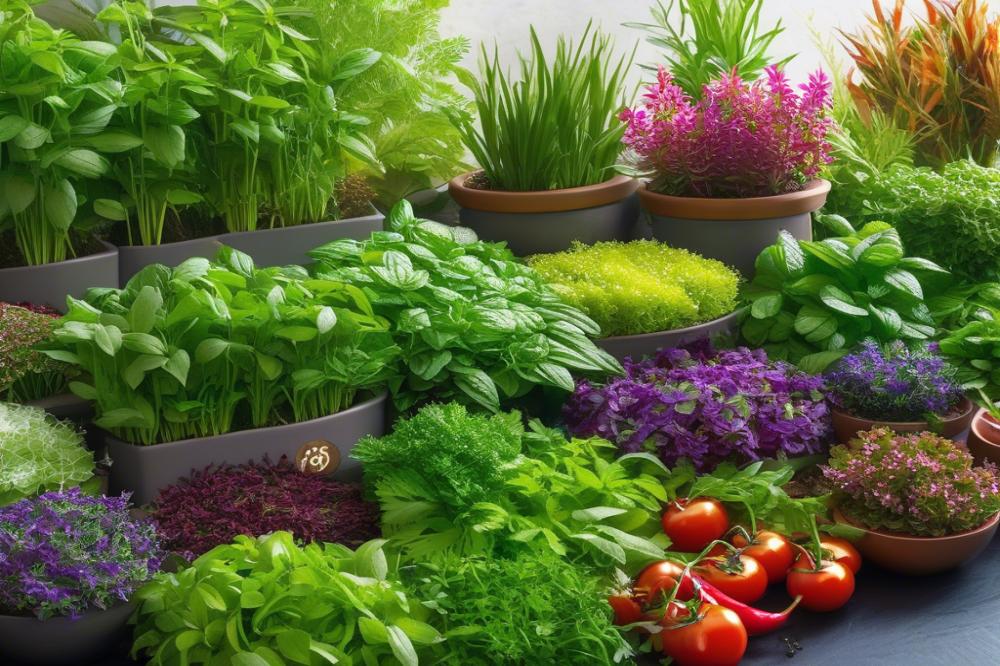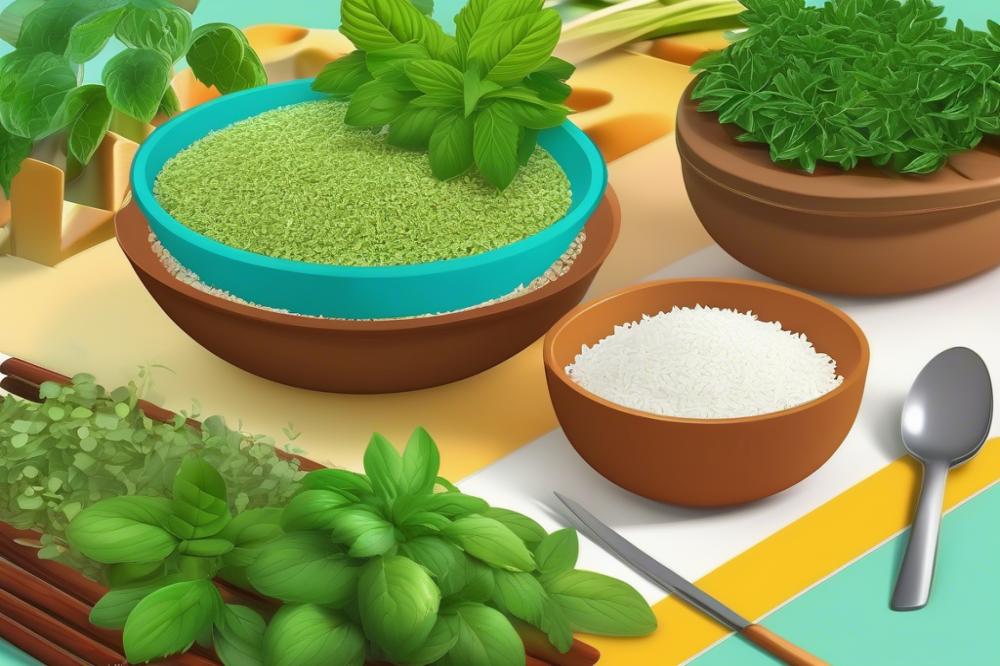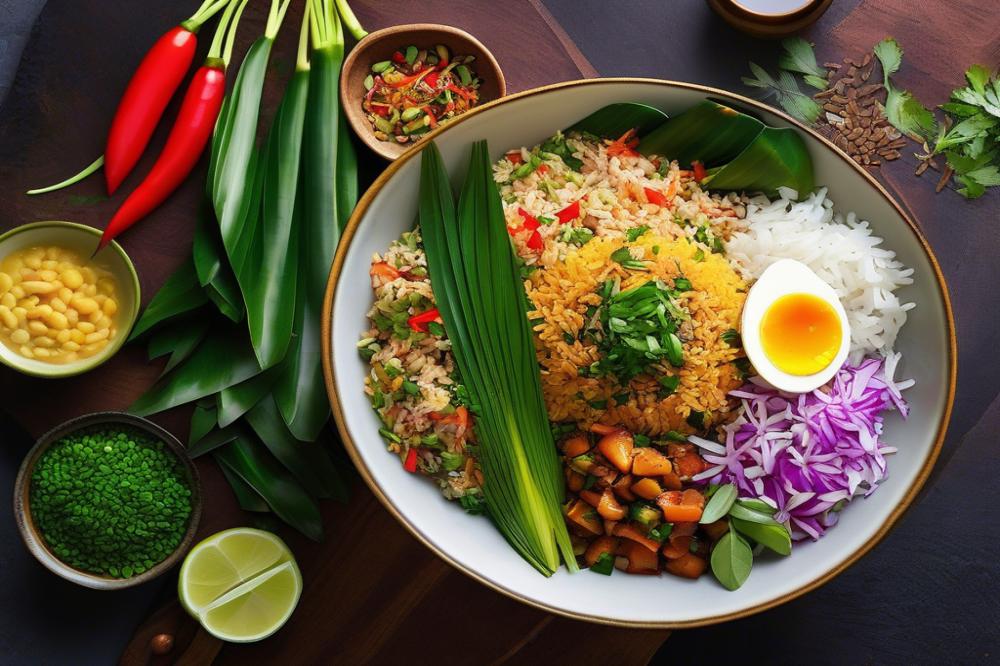Nasi Ulam Recipe: Malaysian Herb rice salad
Overview of Nasi Ulam
Nasi Ulam represents a cherished part of traditional Malaysian cuisine. This vibrant dish combines fragrant rice with a variety of fresh herbs, creating a delightful salad recipe. Many families have passed down the traditional recipe through generations, each adding their own spin to it. The harmony of distinct flavors and textures is what makes this rice salad truly special in Southeast Asian food.
The Role of herbs
Herbs play a vital role in many aspects of Malaysian cuisine. They not only enhance the taste of dishes but also contribute to health benefits. Ingredients like mint, cucumber, and torch ginger bring freshness and aroma to Nasi Ulam. Each herb used in the salad adds its character, making every bite an exciting experience.
A Healthy Choice
This salad is more than just a tasty meal; it is a healthy dish ideal for those seeking vegetarian options. Packed with nutrients, Nasi Ulam offers a balance of carbohydrates, vitamins, and minerals. Cooking this rice salad at home means you can easily customize it with your favorite fresh ingredients. With its colorful presentation and nourishing properties, it’s a satisfying choice for any meal.
Nasi Ulam: A Traditional Malaysian Herb Rice Salad

Nasi Ulam is far more than just a rice dish. This traditional recipe is a vibrant expression of Malaysian culture. People in Malaysia often enjoy this rice salad during gatherings and festivities. The blend of herbs and rice represents the rich culinary heritage of the country. Many families cherish recipes passed down through generations.
This salad showcases a wonderful array of flavors and colors. Each ingredient adds its own distinct note, from the peppery bite of daun kesum to the refreshing taste of mint. A bowl of Nasi Ulam is a feast for the eyes, boasting an energetic mix of greens, often brightened by colorful vegetables. The fragrant rice acts as a base, soaking up all the delicious tastes from the herbs and spices.
Festivals often highlight this healthy dish, with variations across different regions. Some families might include peanuts for added crunch, while others may prefer a richer flavor with coconut. Each version tells a story of its own. Nasi Ulam can easily fit into vegetarian diets, showcasing how Southeast Asian food can be both nutritious and enjoyable. Various recipes exist, but they all celebrate the essence of cooking with fresh, local ingredients.
Ingredients and Cooking Instructions

List of ingredients with quantities:
- 2 cups of cooked fragrant rice (preferably jasmine rice)
- 1 cup of shredded fresh herbs (e.g., mint, basil, and cilantro)
- 1/2 cup of thinly sliced cucumber
- 1/2 cup of grated coconut (fresh or desiccated)
- 1/4 cup of chopped peanuts
- 1/4 cup of sliced shallots
- 2 tablespoons of lime juice
- Salt to taste
Cooking instructions:
- Start by cooking the rice according to the package instructions. Once done, allow it to cool completely.
- Then, take a large bowl and combine the cooled rice with the fresh herbs, cucumber, grated coconut, peanuts, and shallots.
- After that, drizzle lime juice on top and add salt based on your preference.
- Mix everything gently to combine the ingredients well, making sure each bite has a bit of everything.
- Finally, serve the salad chilled or at room temperature for the best experience.
Nutritional information about ingredients
This rice salad is loaded with benefits. Rice serves as a solid carbohydrate source, providing energy for your daily activities. Choosing fragrant rice like jasmine adds a lovely aroma and taste.
Fresh herbs are not just for flavor; they are rich in vitamins and antioxidants. Adding herbs like mint, basil, and cilantro enhances the dish’s nutritional value tremendously. Peanuts provide healthy fats, making this vegetarian dish even more satisfying.
Using fresh produce like cucumber contributes dietary fiber and essential vitamins. Together, these ingredients create a vibrant and healthy dish that celebrates the flavors of Malaysian cuisine. This traditional recipe highlights the freshness found in Southeast Asian food.
Health Benefits of Nasi Ulam

Nasi Ulam is not just a vibrant salad recipe but also a healthy dish packed with nutrients. Each ingredient in this rice salad contributes to wellness. For instance, rice is a source of carbohydrates, providing essential energy. Commonly used herbs like mint, coriander, and basil are rich in vitamins and antioxidants.
Herbs hold a special place in Malaysian cuisine. They provide flavor and myriad health benefits. Mint can aid digestion while rosemary supports memory. Basil is known for its anti-inflammatory properties, and these benefits together enhance overall health.
Incorporating various herbs into daily meals is important. They can add color, taste, and nutrition to any dish. Instead of high-calorie dressings, fresh herbs elevate flavors naturally. This encourages healthy cooking practices in everyday life.
Nasi Ulam is typically low in calories, making it suitable for many diets. Packed with vegetables and fragrant rice, it can be a fulfilling meal that doesn’t weigh you down. For those looking to maintain or lose weight, this vegetarian option is ideal. It allows individuals to enjoy a satisfying meal without excessive calories.
Moreover, this dish highlights the beauty of Southeast Asian food. Traditional recipes like this show how to enjoy tasty meals while still prioritizing health. By enjoying a bowl of Nasi Ulam, one can partake in a culinary experience that nourishes the body and delights the senses.
Serving Suggestions and Pairings
To enhance the meal, traditional accompaniments can make a significant difference. Side dishes like fried tofu or tempeh provide an excellent vegetarian option. They offer a nice contrast to the freshness of the rice salad. Another popular choice is sambal, a spicy chili paste that invigorates the flavors. This adds a touch of heat and is often found in Malaysian cuisine.
For a complete experience, consider serving Nasi Ulam with grilled or fried fish. The flaky texture and subtle flavors of fish complement the fragrant rice beautifully. Chicken satay skewers, marinated in spices before grilling, can also be a delightful pairing. These grilled meats add richness that balances the lightness of the rice salad.
Garnishing and presentation can elevate your meal significantly. Fresh herbs like cilantro or mint can be sprinkled on top, adding a pop of color. Arrange the dish on a large platter to invite sharing; this approach feels festive and communal. Serve it with lemon wedges on the side. This simple touch can enhance the overall flavor and makes for an eye-catching addition to your table.
Another tip is to use various colored vegetables while preparing the vegetable components of this healthy dish. Ingredients like bell peppers or radishes not only add crunch but also create visual interest. Mixing textures and colors will make the dish more appealing. Consider utilizing small bowls for sauces or dips; this allows guests to customize their servings.
Nasi Ulam in Modern Malaysian Cuisine
Over the years, Nasi Ulam has undergone significant changes. Originally a traditional recipe, its roots trace back to the Malay culture. This rice salad showcases a combination of fragrant rice and fresh herbs. Variations now include different grains and additional ingredients. Chefs often experiment with new flavors, making it versatile. As a result, people enjoy it either as a side dish or a main course.
Influence from modern cooking spark interest in contemporary recipes. Innovative chefs incorporate Nasi Ulam into fusion dishes. Vegetarian options have emerged, appealing to health-conscious diners. Creative salads use different fresh vegetables and proteins. These adaptations highlight how this healthy dish remains relevant today. Many recipes now feature accessible ingredients that people can easily find.
Popularity has soared, placing Nasi Ulam in shared dining experiences. Social media boosts awareness, showcasing colorful dishes. Southeast Asian food culture recognizes the salad as an essential element. Many food festivals celebrate this beloved dish. Its unique combination of flavors attracts new fans every day. With each generation, there is a growing appreciation for traditional meals like Nasi Ulam.
Wrapping Up the Delight of Nasi Ulam
Nasi Ulam stands out as a healthy and vibrant rice salad. Combining a variety of fresh herbs with rice creates a dish that is both nutritious and flavorful. This meal reflects the culture of Malaysia, showcasing the importance of fresh ingredients in traditional cooking. Embracing such dishes can lead to a greater appreciation for wholesome eating.
Enjoying traditional Malaysian cuisine in the comfort of your home is an enriching experience. Cooking provides a chance to explore different flavors and techniques. It also brings family and friends together, allowing everyone to share in the joy of food. Finding and preparing authentic meals connects us to places and stories far away.
Trying your hand at making a vibrant herb-infused dish like this can be both fun and rewarding. It encourages culinary exploration and may inspire you to discover more about Malaysian flavors. So, gather your ingredients and dive into the world of Malaysian cooking. You may find a new favorite recipe waiting for you.



